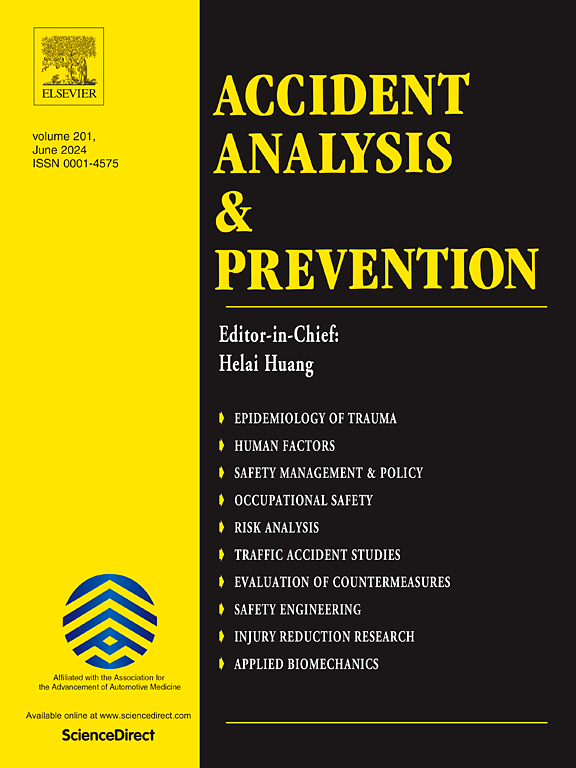Children on wheels: Identifying crash determinants using cluster correspondence analysis
IF 5.7
1区 工程技术
Q1 ERGONOMICS
引用次数: 0
Abstract
Child bicyclists (14 years old and younger) are among the most vulnerable road users, facing significant risks of crashes that often result in severe injuries or fatalities. This study aims to identify key factors influencing child bicyclist crashes and uncover distinct crash patterns using a dataset of 2,394 crashes in Texas from 2017 to 2022. Employing a hybrid approach through machine learning models XGBoost and Random Forest, and Cluster Correspondence Analysis (CCA), the research identified six clusters characterized by unique crash factors and patterns. Moreover, SHAP analysis was conducted on each cluster to further investigate the impact of factors on crash severity. Intersection-related crashes were driven by driver behavior at stop signs and signalized intersections, while urban crashes highlighted risks at marked lanes and driveway access areas. Crashes in residential and rural areas revealed vulnerabilities due to limited traffic control and infrastructure, with rural areas further increased by higher vehicle speeds. Crashes under adverse weather conditions and poor lighting emphasized the role of environmental hazards in increasing crash risks. This study provides countermeasures, including intersection redesigns with protected crossings, expansion of separated bike lanes, and enhanced driveway management. Improved lighting, high-friction road coatings, and weather-specific safety campaigns are recommended to address environmental risks. From a policy perspective, the findings highlight the need for equitable infrastructure investments, stricter enforcement of traffic laws, and educational programs targeting both child bicyclists and drivers. This study also developed an interactive visualization tool that allows users to explore crash locations and related factors. By addressing these challenges, this research offers a framework for improving child bicyclist safety and advancing safer road environments.
车轮上的孩子:使用聚类对应分析识别碰撞决定因素
儿童骑自行车者(14岁及以下)是最脆弱的道路使用者之一,面临严重的碰撞风险,往往导致严重伤害或死亡。本研究旨在确定影响儿童骑自行车事故的关键因素,并利用2017年至2022年德克萨斯州2394起事故的数据集揭示不同的事故模式。该研究采用混合方法,通过机器学习模型XGBoost和随机森林,以及聚类对应分析(CCA),确定了六个具有独特崩溃因素和模式的聚类。并对每个聚类进行SHAP分析,进一步考察各因素对碰撞严重程度的影响。与路口相关的交通事故是由停车标志和信号交叉口的驾驶员行为驱动的,而城市交通事故则是在有标志的车道和车道通道区域发生的。由于交通管制和基础设施有限,住宅和农村地区的撞车事故暴露出脆弱性,农村地区的车速更高,事故数量进一步增加。在恶劣天气条件和光线不足的情况下发生的事故强调了环境危害在增加事故风险中的作用。该研究提出了相应的对策,包括重新设计有保护的交叉路口,扩大独立的自行车道,并加强车道管理。建议改善照明、高摩擦路面涂料和针对天气的安全活动,以应对环境风险。从政策的角度来看,调查结果强调需要公平的基础设施投资,更严格地执行交通法规,以及针对儿童骑自行车者和司机的教育计划。这项研究还开发了一个交互式可视化工具,使用户可以探索坠机地点和相关因素。通过解决这些挑战,本研究为改善儿童骑自行车者的安全和促进更安全的道路环境提供了一个框架。
本文章由计算机程序翻译,如有差异,请以英文原文为准。
求助全文
约1分钟内获得全文
求助全文
来源期刊

Accident; analysis and prevention
Multiple-
CiteScore
11.90
自引率
16.90%
发文量
264
审稿时长
48 days
期刊介绍:
Accident Analysis & Prevention provides wide coverage of the general areas relating to accidental injury and damage, including the pre-injury and immediate post-injury phases. Published papers deal with medical, legal, economic, educational, behavioral, theoretical or empirical aspects of transportation accidents, as well as with accidents at other sites. Selected topics within the scope of the Journal may include: studies of human, environmental and vehicular factors influencing the occurrence, type and severity of accidents and injury; the design, implementation and evaluation of countermeasures; biomechanics of impact and human tolerance limits to injury; modelling and statistical analysis of accident data; policy, planning and decision-making in safety.
 求助内容:
求助内容: 应助结果提醒方式:
应助结果提醒方式:


